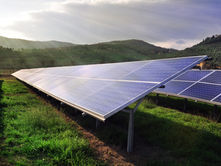top of page
All Articles


Zambia Powers Up: Renewable Energy Revolution Takes Center Stage
Zambia is part of the Africa Minigrids Program (AMP), a UNDP initiative focused on driving private-sector assessment of solar minigrids. They are doing this by implementing cost-reduction strategies and promoting innovative business models. The AMP is funded by the Global Environment Facility (GEF) and implemented in partnership with RMI and the African Development Bank.


Siwa Oasis: A Solar-Powered Transformation Facing Environmental Threats
Solar energy holds immense potential to transform life in the oasis by effectively harnessing its abundant natural resources. However, this potential can only be realized if stringent regulations are established to prevent misuse, ensuring that the intended benefits are not undermined or reversed.


In Zimbabwe, Mini-Power Stations are Driving Change
Mini-grids have the potential to transform Zimbabwe's rural communities, providing clean, reliable energy and driving economic growth. With continued investment and support, these initiatives can help bridge the energy access gap and improve the lives of millions of Zimbabweans.


The Philippines' Nuclear Gamble
Stationed on the western coast of Bataan near the foothills of Mount Natib, the Bataan Nuclear Power Plant (BNPP) has lain dormant for nearly forty years. Commissioned during President Ferdinand Marcos Sr’s administration, the plant was almost completed in 1984, costing the country $2.3 billion. Today, the Philippines is revisiting its nuclear energy ambitions as part of a broader strategy to cut its emissions.


Solar-Powered Irrigation: An Agricultural Revolution Taking Root in Egypt
According to studies, solar-powered irrigation systems are expected to become more feasible and efficient with technological advancements, helping expand the transition from diesel to clean solar energy. This transformation could redefine the future of Egyptian agriculture.


The DRC's Copper Potential
What makes copper so crucial to the global energy transition is that the metal is used in solar panels, wind turbines, power cables, and electrical wiring, writes Shaik Ejamani Peer Mohamed, Senior Consultant for Power Cables at Det Norske Veritas, the Norwegian energy insurance practice. Additionally, electricity demand for household and industrial use is expected to rise annually from 25 Mt currently to 36.6 Mt by 2031. With a supply forecast of 30.1 Mt, the global copper s


Unlocking Africa's Biogas Potential
Despite challenges, biogas has the potential to make a significant impact in Africa. It can be produced on a small scale for household use or on a larger scale for industrial applications. Biogas can provide energy for cooking, lighting, heating, electricity generation, and fertilizer production for agricultural purposes. In fact, researchers are even exploring ways to use biogas systems to produce animal feed.


South Africa's Farmers Riled as Nuclear Waste Heads Their Way
As new nuclear plants take off in South Africa, and an old one is being stretched to life, farmers dread that high-level, radioactive nuclear waste will be buried on their land in a Nevada-like remote district.


In Africa, Solar Energy is Booming
The rise in solar panel imports is a continent-wide phenomenon, with 20 countries setting new records in the 12 months to June 2025. Twenty-five countries imported at least 100 MW, up from 15 countries the previous year. If installed, the solar panels imported into Sierra Leone over the last 12 months would generate electricity equivalent to 61 percent of the country's total reported electricity generation in 2023.


India's Solar Surge
India is building up its domestic solar photovoltaic (PV) manufacturing. With supportive policies, rising domestic demand, and a global push to diversify renewable energy supply chains away from dependence on China, India is working towards solar manufacturing autonomy.


Pumping Life with Solar Power into Zimbabwe's Small-Scale Farms
However, buoyed by low-cost solar-powered water pumps—also known as photovoltaic water pumping systems—some innovative small-scale farmers in Zimbabwe are now able to irrigate their crops and eliminate the need for rain-fed agriculture. According to experts, the use of solar energy to power groundwater pumps by farmers in drought-ridden, off-grid regions in Africa and elsewhere has been heralded as potentially revolutionary.


Spurring Solar Development in Thailand
Despite solar representing the cheapest form of electricity in Thailand since 2022, the roadblocks to solar having a substantial share of Thailand's energy matrix remain prevalent. This is particularly surprising because these solar projects, even when incorporated with batteries, represent a more economic alternative to thermal plants. A report from BloombergNEF found that a solar project with 4 hours of storage will be able to compete with existing thermal power plants this
bottom of page



